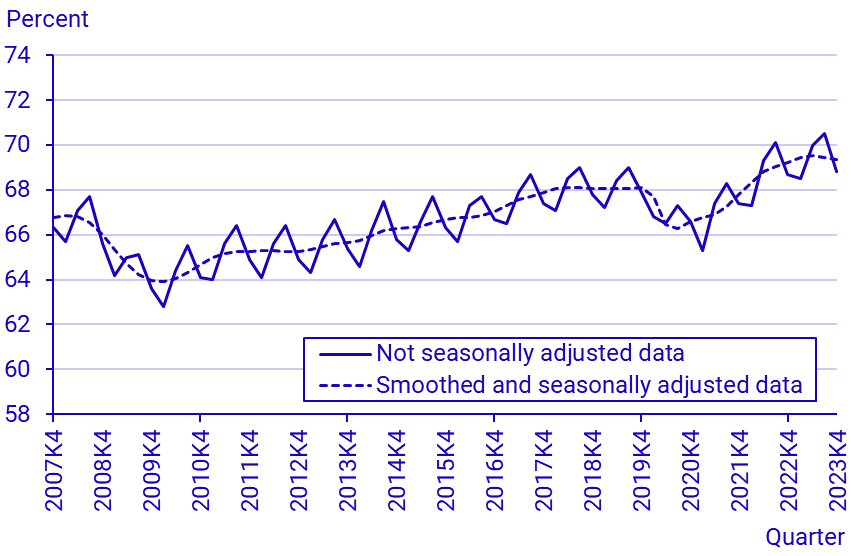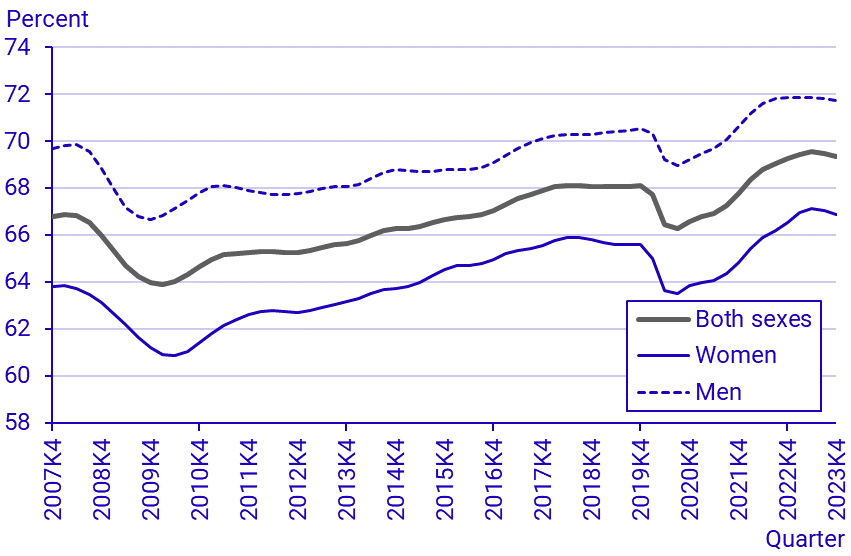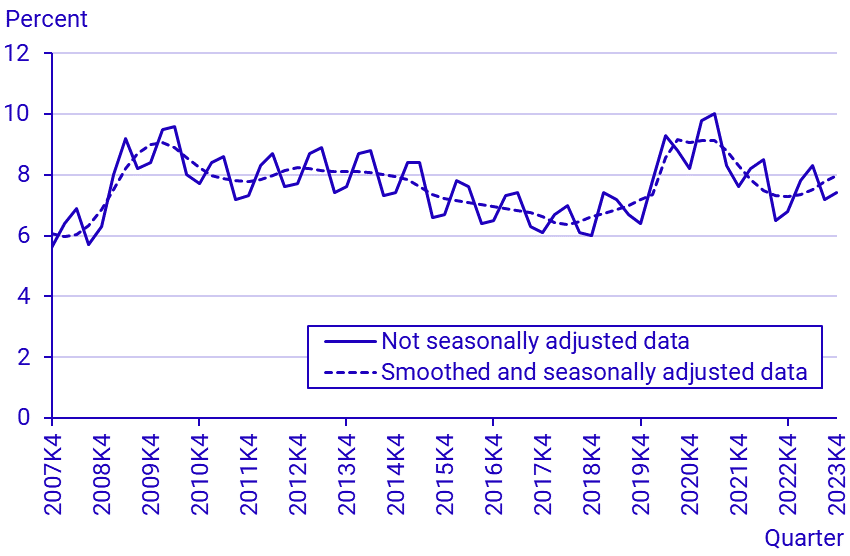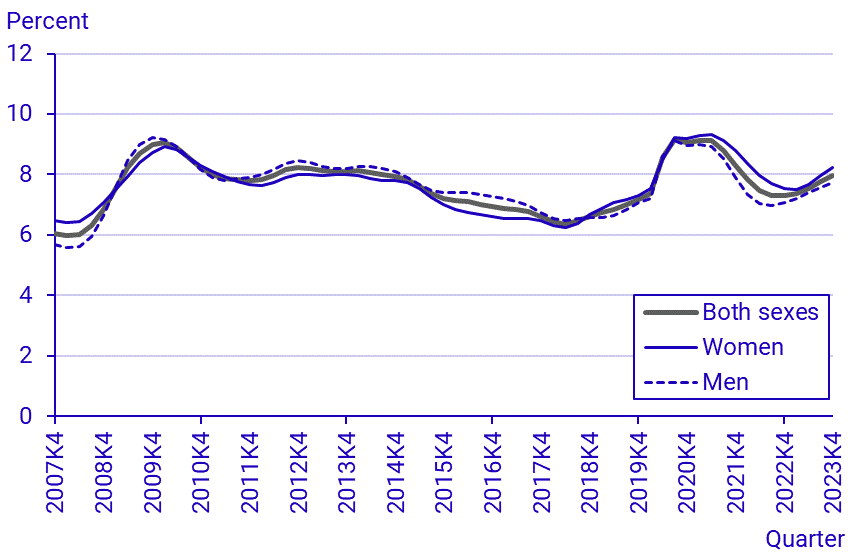Labour Force Survey (LFS), fourth quarter 2023
Unemployment continued to rise during the fourth quarter 2023
Statistical news from Statistics Sweden 2024-02-06 8.00
In the fourth quarter of 2023, the number of employed persons amounted to 5 226 000, not seasonally adjusted. There were 644 000 temporary employees, a decrease of 54 000. The average number of hours worked per week amounted to 164.5 million hours. There were 418 000 unemployed persons, which is an increase of 37 000 persons. This corresponds to an unemployment rate of 7.4 percent, an increase of 0.6 percentage points. Seasonally adjusted and smoothed data shows an increase in both the number and share of unemployed. The seasonally adjusted and smoothed unemployment rate amounted to 8.0 percent.
- The unemployment continued to rise during the fourth quarter. There is also a decrease in the number of temporary employees. This decrease was especially large among young people, says Matilda Wedtström Kjerfh, statistician at the Labour Force Surveys at SCB.
The labour force
The number of persons in the labour force aged 15-74 years increased by 65 000 and amounted to 5 643 000 during the fourth quarter of 2023, not seasonally adjusted. The number of women in the labour force amounted to 2 676 000, an increase of 45 000, and the number of men was 2 967 000. The relative labour force participation rate increased by 0.6 percentage points and amounted to 74.3 percent. Among women, the labour force participation rate amounted to 71.7 percent, an increase of 1.0 percentage point, and the labour force participation rate among men was 76.8 percent.
Seasonally adjusted and smoothed, the number of persons in the labour force during the fourth quarter of 2023 amounted to 5 723 000, which corresponds to 75.3 percent of the population.
Employment
In the fourth quarter of 2023, there were 5 226 000 persons aged 15–74 in employment, not seasonally adjusted, which corresponds to an employment rate of 68.8 percent. Among women, the number of employed was 2 472 000 and the number of men was 2 753 000. The employment rate for women was 66.2 percent and among men it was 71.3 percent. There were 485 000 young people aged 15–24 years in employment. The employment rate for people aged 15-24 was 40.6 percent, a decrease of 1.7 percentage points.
Seasonally adjusted and smoothed, the number of people employed during the fourth quarter of 2023 amounted to 5 267 000. This corresponds to an employment rate of 69.3 percent, which is a decrease compared to adjacent quarters.
Employees
In the fourth quarter of 2023, there were 4 698 000 employees, not seasonally adjusted. Among those, 2 315 000 were women and 2 384 000 were men. There were 4 055 000 permanent employees, an increase of 70 000. Among permanent employees, the number of women increased by 43 000 to 1 962 000 and the number of men was 2 092 000. There were 644 000 temporary employees, a decrease of 54 000. Among them 352 000 were women, a decrease of 27 000, and 291 000 men, a decrease of 27 000. The decrease of temporary employees was particularly large among young persons, aged 15-24, where the number of temporary employees decreased by 30 000 to 228 000.
Compared to adjacent quarters, seasonally adjusted and smoothed data shows a decrease in the number of employees, which amounted to 4 742 000. Among the employees 4 065 000 had a permanent employment and 677 000 a temporary employment. The number of temporary employees decreased compared to adjacent quarters.
Hours worked
The average number of hours worked per week in the fourth quarter of 2023 amounted to 164.5 million hours, not seasonally adjusted. According to seasonally adjusted and smoothed data, the number of hours worked averaged to 156.2 million per week.
The majority of employed persons have an agreed working time of 35 hours or more per week, that is, full-time work. In the fourth quarter of 2023, 4 104 000 persons worked full time. Among them 1 795 000 were women and 2 309 000 were men. In total, 283 000 persons worked short part-time (1–19 hours), and the number of persons who worked long part-time (20-34 hours) amounted to 611 000 persons.1
The average actual hours worked among employed persons aged 15–74 years amounted to 31.6 hours per week in the fourth quarter of 2023. Women worked 29.1 hours per week and men 33.8 hours per week.
Underemployment
Among employed persons aged 15–74, 350 000 were underemployed in the fourth quarter of 2023. This corresponds to an increase of 34 000 compared to the fourth quarter of 2022. The number of underemployed women amounted to 169 000, an increase of 24 000, and the number of men was 181 000. Underemployed persons accounted for 6.7 percent of employed persons.
Unemployment
In the fourth quarter of 2023, there were 418 000 unemployed persons aged 15–74, not seasonally adjusted. This is an increase of 37 000 persons compared to the corresponding quarter previous year. The unemployment rate amounted to 7.4 percent, an increase of 0,6 percentage points. There were 204 000 unemployed women and 214 000 unemployed men. The unemployment rate for women was 7.6 percent and the male unemployment rate was 7.2 percent.
For persons aged 15–74, seasonally adjusted and smoothed data shows an increase in the number and share of unemployed persons compared to adjacent quarters. The number of unemployed amounted to 456 000 in the fourth quarter 2023, which corresponds to an unemployment rate of 8.0 percent.
There were 140 000 long-term unemployed persons (unemployed for at least 27 weeks) aged 15–74 years in the fourth quarter of 2023, not seasonally adjusted. Among long-term unemployed persons, the number of women was 68 000 and the number of men amounted to 72 000.
There were 125 000 unemployed young persons aged 15–24, not seasonally adjusted. This corresponds to an unemployment rate of 20.5 percent. Among unemployed young people, 79 000 persons were full-time students. For persons aged 15–24, seasonally adjusted and smoothed data shows an increase in the number and the share of unemployed persons compared to adjacent quarters. The number of unemployed young persons amounted to 153 000, corresponding to an unemployment rate of 22.5. percent.
Not in the labour force
The group 'not in the labour force' includes persons who are not classified as employed nor as unemployed. In the fourth quarter of 2023, there were 1 953 000 persons not in the labour force, which is a decrease of 39 000 compared to the fourth quarter of 2022. The number of women not in the labour force was 1 057 000, a decrease of 33 000, and the number of men was 897 000.
Among persons not in the labour force, 858 000 were retired, 643 000 were full-time students and 293 000 persons reported that they were on long-term sick leave.
Latent job seekers
There were 288 000 latent job seekers aged 15–74 years in the fourth quarter of 2023, an increase of 34 000 people. Among them, 134 000 were women and the number of men increased by 27 000 to 154 000. Among young people aged 15–24, the number of latent job seekers was 153 000, an increase of 31 000 people.
Unused labour supply
Unemployed persons, underemployed persons and latent job seekers together comprise the unused labour supply. In the fourth quarter of 2023, the unused labour supply averaged 22.0 million hours per week, an increase of 2.0 million hours compared to the corresponding quarter in 2022. The unused labour supply corresponds to 550 000 full-time employments with 40-hour work weeks.
Labour market for persons aged 20-64 years
The population presented by the LFS is comprised of persons aged 15–74 years. However, labour market participation among younger and older in this age group is considerably lower for natural reasons, as this group contains large shares of students and retired persons. To better approach what can be seen as the core of the actively working population, the situation of the age group 20–64 years is described in the following section.
The relative labour force participation rate among persons aged 20–64 years amounted to 88.2 percent in the fourth quarter of 2023, not seasonally adjusted. This was an increase of 1.1 percentage points compared to the corresponding quarter in 2022. For women, the relative workforce participation rate was 85.6 percent, an increase of 1.7 percentage points, and for men it was 90.7 percent. Compared to adjacent quarters, seasonally adjusted and smoothed data shows an increase in the labour force participation rate, which amounted to 88.7 percent.
In the fourth quarter of 2023, the share of employed persons aged 20–64 was 82.4 percent, not seasonally adjusted. For women, the corresponding figure was 79.8, an increase of 1.0 percentage point, and for men it was 84.9 percent. The employment rate amounted to 82.7 percent according to seasonally adjusted and smoothed data.
According to not seasonally adjusted data, the unemployment rate in the age group 20–64 amounted to 6.5 percent in the fourth quarter of 2023, an increase of 0.6 percentage points. The unemployment rate among women was 6.7 percent and for men it was 6.3 percent. According to seasonally adjusted and smoothed data, the unemployment rate was 6.9 percent which was an increase compared to adjacent quarters.
Swedish born and foreign born persons aged 20–64 years
The relative labour force participation rate among Swedish born persons, aged 20–64 years was 88.6 percent in the fourth quarter of 2023, not seasonally adjusted. This was an increase of 0.8 percentage points compared to the corresponding quarter last year. Among Swedish born women it was 87.3 percent, an increase of 1.5 percentage points, and among Swedish born men it was 90.0 percent. Among foreign born persons aged 20–64 years, the relative labour force participation rate was 86.9 percent, an increase of 1.8 percentage points. The corresponding figure among foreign born women was 81.1 percent, an increase of 2.7 percentage points, and 92.5 percent among foreign born men. According to seasonally adjusted and smoothed data, the labour force participation rate was 89.2 percent among Swedish born persons and 87.6 percent among foreign born persons. There was an increase in the share of the labour force, both among Swedish born and foreign born persons compared to adjacent quarters.
In the fourth quarter of 2023, the share of employed, Swedish born persons, aged 20–64 was 85.4 percent, not seasonally adjusted. Among Swedish born women, the employment rate was 84.1 percent and among Swedish born men the employment rate was 86.7 percent. Among foreign born persons, the employment rate was 74.4 percent. Among foreign born women, the employment rate was 68.2 percent and among foreign born men it was 80.2 percent. Seasonally adjusted and smoothed data shows that the employment rate was 85.6 percent among Swedish born persons and 74.7 percent among foreign born persons. There was an increase in the share of employed among Swedish born persons and a decrease among foreign born persons, compared to adjacent quarters.
The relative unemployment rate among Swedish born persons aged 20–64 years was 3.6 percent in the fourth quarter of 2023, not seasonally adjusted. This was an increase of 0.6 percentage points compared to the corresponding quarter in 2022. Among Swedish born women, the unemployment rate was 3.6 percent, and the male unemployment rate was 3.7 percent. The unemployment rate among foreign born persons was 14.4 percent. Among foreign born women it was 15.9 percent and among foreign born men the corresponding number was 13.2 percent. Seasonally adjusted and smoothed data shows that the unemployment rate was 4.0 percent among Swedish born persons and 14.7 percent among foreign born persons. This was an increase for both Swedish born and foreign born persons compared to adjacent quarters.
1) Agreed working time in 2021 and 2022 excludes secondary jobs, this because the agreed working time in secondary jobs has not been collected since the implementation of the EU regulation 2019/1700. As of January 2023, the question regarding agreed working time in secondary jobs was reintroduced and total agreed hours worked are again reported in the Swedish LFS. However, comparisons with the corresponding quarter of the previous year are excluded during 2023.




Source: Statistics Sweden
Definitions and explanations
Since the LFS is a sample survey, the results are subject to some uncertainty. The LFS basic tables contain uncertainty figures and refer to non-seasonally adjusted data.
Seasonally adjusted and smoothed data (trend values): data in which normal seasonal variations have been removed, then smoothed to reduce sampling error and short-term variations. Seasonally adjusted and smoothed data may be revised following new monthly outcomes and usually does not coincide with non-seasonally adjusted data. Seasonally adjusted and smoothed data is not to be compared with non-seasonally adjusted data.
More detailed results are available in the form of figures and tables on employed persons, hours worked, unemployed persons and more, on Statistics Sweden’s website.
Next publishing will be
2024-02-16, at 08:00.
Feel free to use the facts from this statistical news but remember to state Source: Statistics Sweden.
